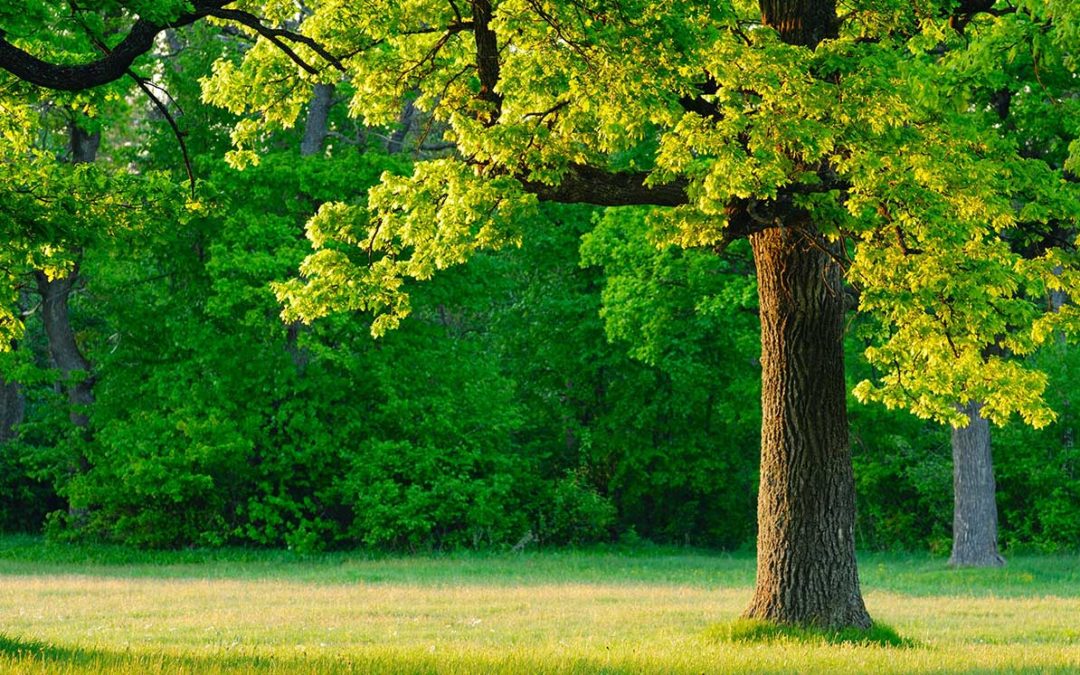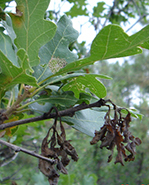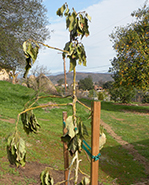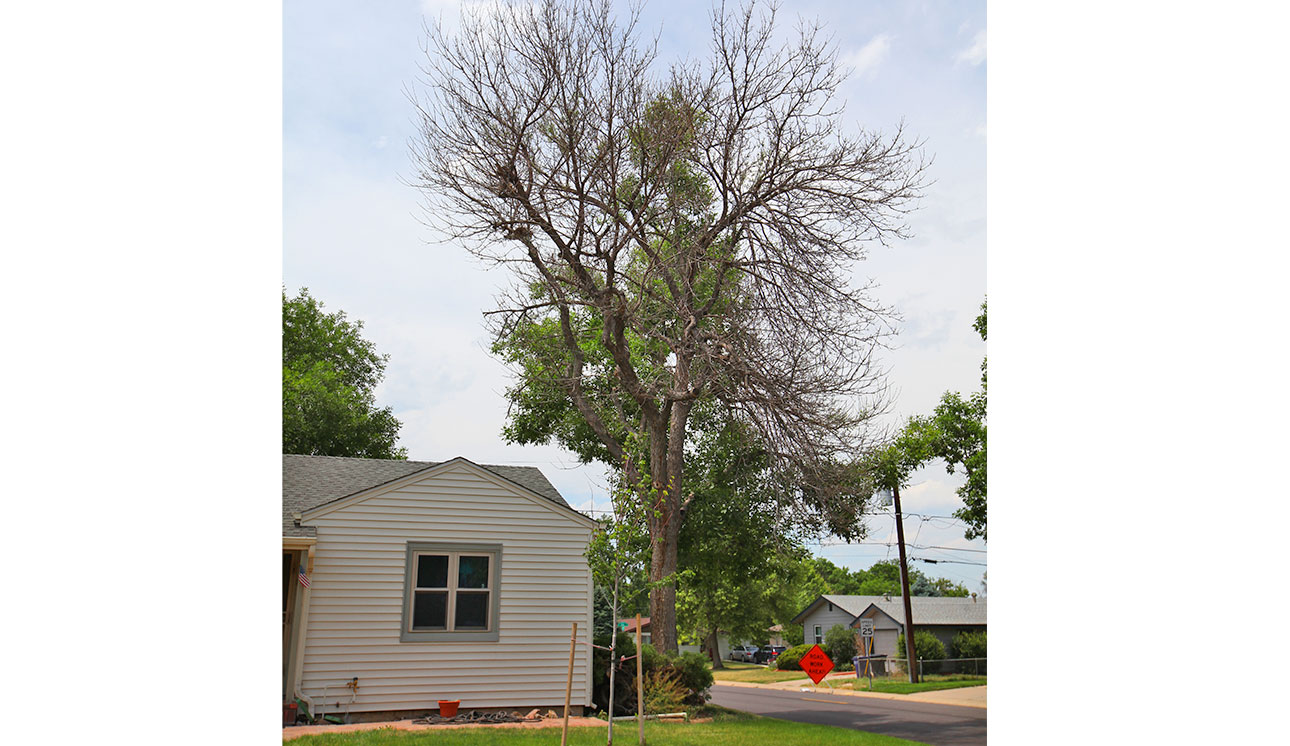Summer Tree Care Tips
As Ross Tree’s General Manager explains in the video below, summer is an excellent time to get your trees ready to withstand Denver’s unpredictable weather. He recommends increasing deep rooting feeding to at least two times during the growing season and deep root watering as needed during the hot days of the summer. Also, proper tree pruning forms a dominant leader and thins out the crown to withstand mechanical breakage from snow and wind. Next, he discusses Twig Beetles and aphids that his crews are seeing in big numbers this summer.
Denver is known for its polar plunges in early spring and the fall. In the fall, warm weather delays a tree’s hardening process to prepare for winter, while in the spring, as the weather warms, trees start to leaf out. Then the temperature suddenly drops, and trees get clobbered by a hard frost, damaging their branch, leaf, and bud tissues. In 2020, Ash trees got nipped, and in 2021, the Lindens got hit hard. By June, any frost damage becomes apparent. However, most trees repair themselves, so homeowners should wait until new growth appears before making any tree care decisions. It’s sad, but any tree that looks dormant or half-dead in July most likely requires tree removal.
Wondering What Is Wrong With Your Trees?
They could be frost-damaged. Denver is known for its polar plunges in early spring and the fall. In the fall, warm weather delays a tree’s hardening process to prepare for winter, while in the spring, as the weather warms, trees start to leaf out. Then the temperature suddenly drops, and trees get clobbered by a hard frost, damaging their branch, leaf, and bud tissues. In 2020, Ash trees got nipped, and in 2021, the Lindens got hit hard. By June, any frost damage becomes apparent. However, most trees repair themselves, so homeowners should wait until new growth appears before making any tree care decisions. It’s sad, but any tree that looks dormant or half-dead in July most likely requires tree removal. Check out the characteristics of freeze damage in different types of trees:
- Evergreens
Polar plunges turn new needle growth on Pine and Spruce trees brown. Most trees recover as new needles emerge in the spring. By June, if the tree remains brown, it is dead and needs removal. - Deciduous
Sudden freezes kill trigs and branches in hardwood trees, producing “winter kill” in the spring. Sometimes frozen trees keep their leaves over the winter, dropping them during the next growing season. - Newly Planted Trees
Unfortunately, many newly planted trees die after an unexpected hard freeze. So, dig up the sapling and plant some flowers in its place. Click here to sign up for Denver Digs Trees’ free tree giveaway the following spring.
What Type of Pruning Restores a Frost Damaged Tree?
Sometimes it takes an arborist with a bucket truck to figure out how to prune a frost-damaged tree to get it back to a healthy, safe, and attractive condition. A good summer tree care tip is to prune out dead branches. Tree trimming also encourages healthy growth by opening up the crown to more light and air. Arborists use the following types of pruning to repair frost-damaged trees. For more information about standards-based tree pruning practices, click here.
- Cleaning – Removes dead or weakly attached branches from the crown of a tree.
- Thinning – Opens the foliage of a tree, reduces weight, and helps retain the tree’s natural shape.
- Structural – Creates a dominant leader and cuts back secondary branches to make the trees more resistant to snow and wind damage.
- Reduction – Reduces the size of a tree by pruning the deadwood back to secondary branches.
The mature Ash tree below has significant frost damage. About half the tree is dead, but most laymen would say the tree is salvageable. Still, David Boswell, Ross Tree’s General Manager, says that “This tree probably needs removal because of the amount of canopy loss. The epicormic growth on the tree shows the tree is in decline.”

Pruning Young Trees
Another summer tree care tip is training and pruning young trees to encourage healthy growth and a desirable structure. Pruning starts by establishing a single dominant leader. Trees with good form require less pruning as they mature, saving money in the long run. Click here for more information about caring for newly planted trees.
Controlling Soft Bodied Tree Insects
As David mentioned above, the wet spring natured the growth of many soft body tree pests. So a good summer tree care tip is controlling tree Scales, Mites, and Aphids. Ross Tree, a leading innovator in tree insect control, recommends systemic tree injections to manage these insects. Using systemics ensures that only the tree gets the product, not the surrounding environment. Click here for more information about using systemic products to control tree insects.
How to Make Denver’s Soils More Hospitable to Tree Growth?
Since trees are not native to Denver, it makes sense that they need supplemental fertilizer and water to grow here better. A tree root system consists of large perennial roots and short-lived feeder roots. The perennial roots grow in the top 6 to 24 inches of soil around the tree but sometimes go deeper if conditions permit. Feeder roots average about 1/16 inch in diameter and account for most of the surface area of the root system. These roots grow near the soil surface, where they absorb water, minerals, and oxygen. Tree root systems extend outward past the diameter of the tree’s crown. A common tree issue is Denver’s notorious clay soils. Some trees grow poorly in clay soils because of lack of aeration, which decreases the ability of the root systems to replenish water loss brought about by our dry climate. Homeowners should look for the following:
- Stunted Growth – Your tree is not growing as fast, or the leaves seem smaller than expected. Clay soils do stunt growth, and fertilization reverses this condition.
- Leave Discoloration – Leaf discoloration is a sign of infestation or disease, but it could be that your trees are not getting enough nutrition. Red and Freeman Maples and some Oaks are prone to Chlorosis or yellowing of leaves. Affected trees cannot take up iron from the soil, so their leaves turn yellow.
- Overwatering – Overwatering in heavy soils reduces the amount of air and oxygen available to roots.
A good summer tree care tip is to break up heavy soils. Ross Tree applies fertilizers and soil amendments in the manner prescribed by the manufacturer. We use the following products:
- Cambistat – Regulates tree growth and strengthens root systems.
- Biochar – Breaks down heavy soils allowing root systems to expand and grow. Microbes thrive in the ground improving soil structure.
Deep Root Watering
The amount of water a tree needs depends on its size, stress, sun exposure, and soil type. Watering too much is just as damaging as too little water, so sometimes, it is best to contact an expert to get the watering volume and frequency right. Below are several watering tips.
- Water Injection – Tree service companies use deep root forks or needles to inject water into the ground from the trunk to the drip line at a depth of 8 to 12 inches.
- Consistent moisture – Maintaining soil moisture allows for better root absorption of water. Dried-out or waterlogged soils make trees vulnerable to disease and insect infestations, as well as branch dieback.
- Newly planted trees – Young trees need water every three or five days after planting. Also, be sure to water them during drought conditions in the summer and winter.
- Rule of Thumb – Apply 10 gallons of water per inch of tree diameter. For small trees, this is not a big task. Still, for larger ones, we recommend calling a professional tree service company that possesses the water tanks, injectors, and other equipment needed for larger jobs.
- Mulch Trees – Wood chip, bark, leave, and evergreen needle mulch conserves soil moister but be sure to leave a six-inch space between the mulch and trunk of trees.
Click here for more information about deep root feeding.
Chlorosis or Yellowing of Leaves
Another summer tree issue is the leaves on Maples and some Oaks turning yellow. Denver’s high clay soils make iron unavailable to the root systems of some trees. Tree roots struggle to take up the element, and the Chlorosis worsens as the summer progresses. Affected trees decline, turn yellow, and eventually die if the iron deficiency is not corrected. Homeowners experiencing Chlorosis should call a certified arborist. Once on-site, the arborist will inspect the trees, identify species, and select the best treatment to remedy the situation. One of the most common therapies injects an iron solution into the trunk every few years. Applying chelated iron fertilizer is another option. These fertilizers amend the soil and make iron available to a tree’s root system.
The top summer tree care tip is keeping trees watered and fertilized. A well-thought-out summer tree fertilization and watering maintenance program helps Ash, Linden, Maples, Elms, and other yard trees get through hot summers and allows them to withstand Denver’s unpredictable weather in the spring and fall. To set up an appointment, call 303-871-9121 or click here to fill out a tree service request form.





